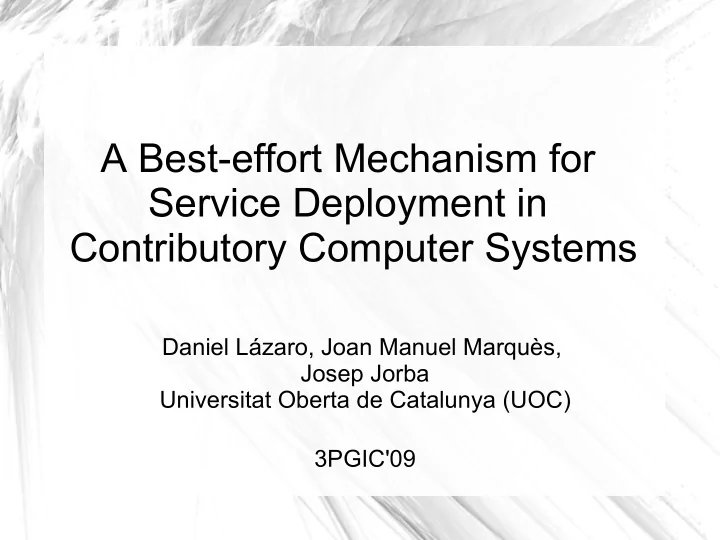

A Best-effort Mechanism for Service Deployment in Contributory Computer Systems Daniel Lázaro, Joan Manuel Marquès, Josep Jorba Universitat Oberta de Catalunya (UOC) 3PGIC'09
Outline ● Introduction ● Architecture ● Mechanisms – Service creation – Service activation ● Validation ● Conclusions
Introduction ● Contributory computer system: – Users provide their own resources to be used collectively. – The use of the resources is determined by the functionality and objective of the specific contributory application.
Introduction Contributory systems ● Main characteristics: – Unpredictable individual resource availability. – Heterogeneity. – Ease of use.
Introduction Service deployment ● Service deployment as building block for contributory applications: – Centralized componens deployed as services can make applications easer to build. ● Service: – Always available in the community, – Offers a functionality. E.g.: ● Web server ● Video conversor
System model
Architecture
Mechanisms
Mechanisms
Mechanisms
Service creation
Service creation
Service activation
Service activation
Service activation
Service activation
Validation ● Implemented in DHT simulator PlanetSim. – Chord DHT. ● Centralized resource prospector. ● No specific resource requirements. ● Different configurations – Node availability: 30%, 50%, 80% – Community size: 100, 500, 1000, 5000 nodes
Validation 100 90 80 Service Availability 70 60 30% node av. 50 50% node av. 80% node av. 40 30 20 10 0 100 500 1000 5000 Community size
Validation 8000 7000 Mean length of availability intervals 6000 5000 30% node av. 4000 50% node av. 80% node av. 3000 2000 1000 0 100 500 1000 5000 Community size
Validation 180 160 Mean length of unavailability intervals 140 120 100 30% node av. 50% node av. 80 80% node av. 60 40 20 0 100 500 1000 5000 Community size
Conclusions ● We have presented a best effort mechanism for service deployment. ● Offer good availability for services from multiple low-availability resources. ● Future work: – Test its performance with a variety of requirements and resources. – Choose an scalable mechanism for resource discovery.
Thanks for your attention
Recommend
More recommend